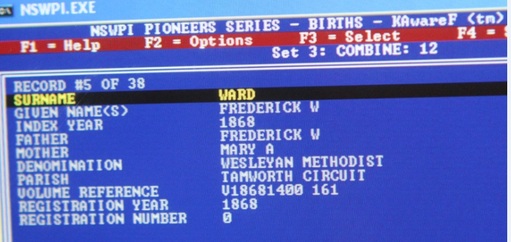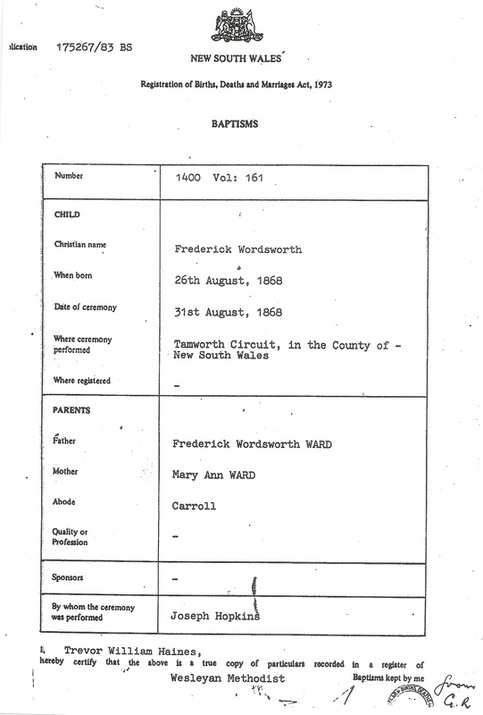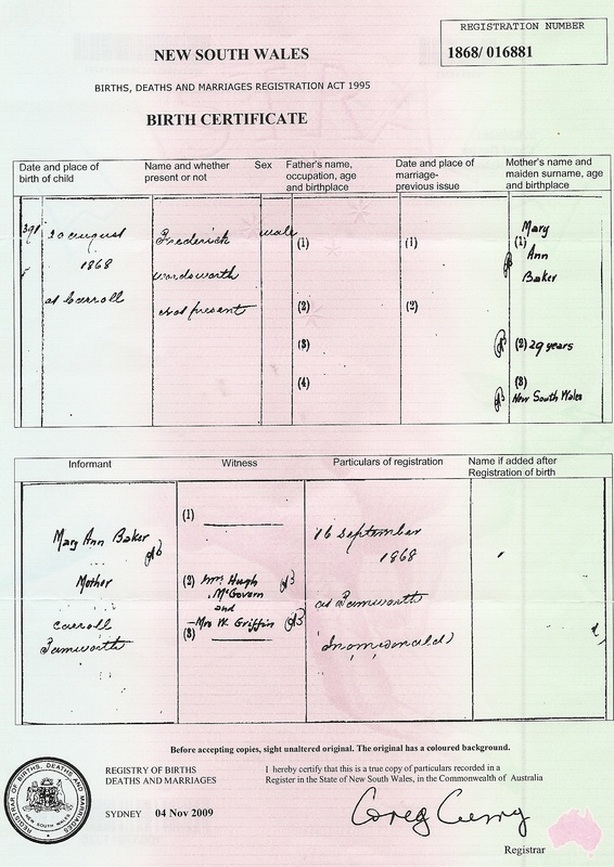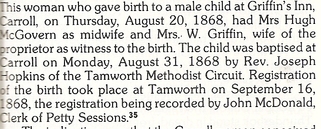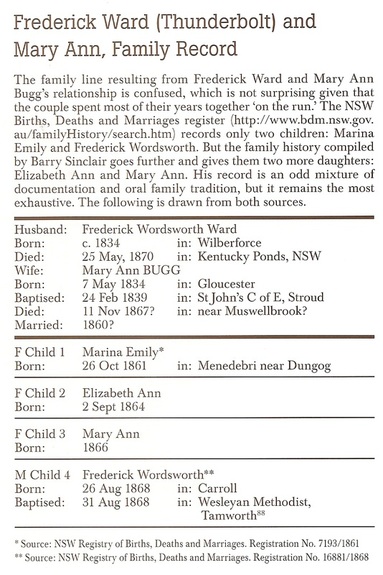Frederick Wordsworth Ward junior
Frederick Wordsworth Ward junior was the youngest child born to Frederick Wordsworth Ward (aka Captain Thunderbolt) and his paramour Mary Ann Bugg. An early reference to him surfaced in 1941 in a report written by the Honorary Secretary of the Tenterfield District Historical Society (see Report). So what does this letter actually tell us? To summarise, the report says:
- That the child, Frederick Wordsworth Ward, was the son of Frederick Wordsworth Ward and Mary Ann Ward;
- That Frederick Wordsworth Ward snr was the bushranger Thunderbolt;
- That the child was baptised on 31 August 1868;
- That the child was baptised in a Methodist ceremony performed by Rev J. Hopkins;
- That the ceremony was performed “at a small centre between Tamworth and Gunnedah”; and
- That the report refers only to the child's baptism, not his birth.
Fortunately, a reference to the child's actual baptism entry is included in the NSW Registry of Births, Deaths and Marriages indexes. While the Online Index entry does not mention where the child was baptised, the old CD-Rom Pioneers Index 1788-1888 did note this information, as shown below:
- That the child, Frederick Wordsworth Ward, was the son of Frederick Wordsworth Ward and Mary Ann Ward;
- That Frederick Wordsworth Ward snr was the bushranger Thunderbolt;
- That the child was baptised on 31 August 1868;
- That the child was baptised in a Methodist ceremony performed by Rev J. Hopkins;
- That the ceremony was performed “at a small centre between Tamworth and Gunnedah”; and
- That the report refers only to the child's baptism, not his birth.
Fortunately, a reference to the child's actual baptism entry is included in the NSW Registry of Births, Deaths and Marriages indexes. While the Online Index entry does not mention where the child was baptised, the old CD-Rom Pioneers Index 1788-1888 did note this information, as shown below:
The above entry provides some useful information. The references to "Wesleyan Methodist" and "Tamworth Circuit" indicates that this index entry relates to a baptism rather than a birth certificate, which is confirmed the entry's reference number – V18681400 161.
To understand the significance of the entry number, one needs to decode it, as follows:
- V: for Volume, which means that the entry relates to a church volume (eg. baptism, marriage or burial) rather than a civil registration (eg. birth, marriage or death certificate). NB. Civil registration began in 1856 in New South Wales. Prior to that, baptism, marriage and burial entries served as pseudo "certificates" on the rare occasions they were needed. Of course, baptism and burial ceremonies were voluntary church ceremonies and were only registered if performed. Many children were not baptised and many bodies were dropped into holes in the ground without any clergyman attending.
- 1868: this relates to the birth year of the child being baptised. As mentioned above, baptism entries served as pseudo birth certificates for the period prior to civil registration. However, a baptism ceremony could be performed at any time in a person's life, even when that person was an adult so, if the index entry for a person's baptism mentioned only the baptism year, the entry might be unlocatable. That being the case, the indexing staff used the birth date rather than the baptism date to ensure that this information was readily accessible (although there were exceptions to this rule). So the index entry "V1868" indicates that it refers to a baptismentry for a child born in 1868.
- 1400: this represents the entry number in the relevant church register volume.
- 161: this represents the volume number of the church register that contains the baptism.
The following is a copy of the official certificate issued by the Register of Births, Deaths and Marriages for the baptism of Frederick Wordsworth Ward junior, the certificate that is accessed using the index entry displayed above. Note the following:
- That the certificate is shown to be a Baptism Certificate with the number 1400 from volume 161;
- That it lists the child as having the given names Frederick Wordsworth;
- That it lists the child's baptism date as 31 August 1868;
- That it reports that the baptism ceremony was performed in the Tamworth Circuit;
- That it lists the child's parents as Frederick Wordsworth Ward and Mary Ann Ward;
- That it notes that the ceremony was performed by Joseph Hopkins; and
- That it notes that the ceremony was performed according to the rites of the Wesleyan Methodist church.
To understand the significance of the entry number, one needs to decode it, as follows:
- V: for Volume, which means that the entry relates to a church volume (eg. baptism, marriage or burial) rather than a civil registration (eg. birth, marriage or death certificate). NB. Civil registration began in 1856 in New South Wales. Prior to that, baptism, marriage and burial entries served as pseudo "certificates" on the rare occasions they were needed. Of course, baptism and burial ceremonies were voluntary church ceremonies and were only registered if performed. Many children were not baptised and many bodies were dropped into holes in the ground without any clergyman attending.
- 1868: this relates to the birth year of the child being baptised. As mentioned above, baptism entries served as pseudo birth certificates for the period prior to civil registration. However, a baptism ceremony could be performed at any time in a person's life, even when that person was an adult so, if the index entry for a person's baptism mentioned only the baptism year, the entry might be unlocatable. That being the case, the indexing staff used the birth date rather than the baptism date to ensure that this information was readily accessible (although there were exceptions to this rule). So the index entry "V1868" indicates that it refers to a baptismentry for a child born in 1868.
- 1400: this represents the entry number in the relevant church register volume.
- 161: this represents the volume number of the church register that contains the baptism.
The following is a copy of the official certificate issued by the Register of Births, Deaths and Marriages for the baptism of Frederick Wordsworth Ward junior, the certificate that is accessed using the index entry displayed above. Note the following:
- That the certificate is shown to be a Baptism Certificate with the number 1400 from volume 161;
- That it lists the child as having the given names Frederick Wordsworth;
- That it lists the child's baptism date as 31 August 1868;
- That it reports that the baptism ceremony was performed in the Tamworth Circuit;
- That it lists the child's parents as Frederick Wordsworth Ward and Mary Ann Ward;
- That it notes that the ceremony was performed by Joseph Hopkins; and
- That it notes that the ceremony was performed according to the rites of the Wesleyan Methodist church.
The Baptism Certificate shown above is the official copy of the baptism entry mentioned by the Tenterfield District Historical Society in relation to Thunderbolt's son, Frederick Wordsworth Ward junior. It is here published online for the very first time. This particular
Baptism Certificate is extremely important because it provides information that
the Tenterfield report omitted, namely:
- that the child Frederick Wordsworth Ward jnr was born in August 1868;
- that the parent’s "abode" was listed as Carroll (which is indeed a "small centre lying between Tamworth and Gunnedah", as mentioned in the Tenterfield Report). Some researchers have cited the Tenterfield report to suggest that Fred jnr was born in 1867. Actually, the Report makes no mention whatsoever of Frederick jnr's birth date. Nor does it provide any information to suggest that the child might have been born in 1867. Rather the official Baptism Certificate makes it clear that the child Frederick Wordsworth Ward was born in 1868.
An obvious question: why would the Registry of Births, Deaths and Marriages include an entry for a baptism ceremony performed years after the commencement of civil registration? I will explain.
As mentioned above, "civil registration" – that is, the official registration of births, deaths and marriages – began in 1856 in NSW, two decades after the mother country. England commenced civil registration in 1837 but their system gathered only brief information about the parties involved. Scotland began civil registration in 1855, using a system that gathered more detailed information, although they reduced the complexity of the gathered information a year later. Fortunately, NSW followed the earlier Scottish system meaning that our birth, marriage and death certificates are arguably the best in the world. Indeed the secondary-source information provided on our certificates makes them a boon for family historians. But, unfortunately, not every event was registered, nor was every piece of requested information provided.
While the civil registration legislation obliged people to register births, deaths and marriages or face punishment, many people did not do so, sometimes because they didn't know about the legislation, sometimes because they didn't care about the legislation, and sometimes because they were wary about bureaucracy and the intrusion of "authority" into their personal lives. But the need to have "legal" evidence of a person's birth, marriage and death became more and more important as the decades passed, one reason being, for example, to prove a birth-date so as to be eligible for the aged pension. So the authorities gathered the church registers together (those they had access to) and paid staff to compare the entries in the church registers with those found in the civil records. If the staff found entries that were missing from the civil records, they produced an index entry for the church register entry and added that to their index system. They also numbered the church register volumes so the entry itself could be readily located and used to provide an official certificate if necessary.
So, the fact that the NSW Registry indexes includes an entry for the baptism of Frederick Wordsworth Ward jnr means that, when the staff compared the various registers, they could find no birth certificate registration for the same child. Not at that time, anyway.
Many of the church registers used by the Registry are now on open access at State Records, Kingswood, and the Wesleyan registers are among them. Accordingly, the baptism entry for Frederick Wordsworth Ward jnr can be viewed by anyone – although it cannot be not photocopied (the Registry expects people to pay them for a copy!). I viewed the entry and my transcription is shown below:
- that the child Frederick Wordsworth Ward jnr was born in August 1868;
- that the parent’s "abode" was listed as Carroll (which is indeed a "small centre lying between Tamworth and Gunnedah", as mentioned in the Tenterfield Report). Some researchers have cited the Tenterfield report to suggest that Fred jnr was born in 1867. Actually, the Report makes no mention whatsoever of Frederick jnr's birth date. Nor does it provide any information to suggest that the child might have been born in 1867. Rather the official Baptism Certificate makes it clear that the child Frederick Wordsworth Ward was born in 1868.
An obvious question: why would the Registry of Births, Deaths and Marriages include an entry for a baptism ceremony performed years after the commencement of civil registration? I will explain.
As mentioned above, "civil registration" – that is, the official registration of births, deaths and marriages – began in 1856 in NSW, two decades after the mother country. England commenced civil registration in 1837 but their system gathered only brief information about the parties involved. Scotland began civil registration in 1855, using a system that gathered more detailed information, although they reduced the complexity of the gathered information a year later. Fortunately, NSW followed the earlier Scottish system meaning that our birth, marriage and death certificates are arguably the best in the world. Indeed the secondary-source information provided on our certificates makes them a boon for family historians. But, unfortunately, not every event was registered, nor was every piece of requested information provided.
While the civil registration legislation obliged people to register births, deaths and marriages or face punishment, many people did not do so, sometimes because they didn't know about the legislation, sometimes because they didn't care about the legislation, and sometimes because they were wary about bureaucracy and the intrusion of "authority" into their personal lives. But the need to have "legal" evidence of a person's birth, marriage and death became more and more important as the decades passed, one reason being, for example, to prove a birth-date so as to be eligible for the aged pension. So the authorities gathered the church registers together (those they had access to) and paid staff to compare the entries in the church registers with those found in the civil records. If the staff found entries that were missing from the civil records, they produced an index entry for the church register entry and added that to their index system. They also numbered the church register volumes so the entry itself could be readily located and used to provide an official certificate if necessary.
So, the fact that the NSW Registry indexes includes an entry for the baptism of Frederick Wordsworth Ward jnr means that, when the staff compared the various registers, they could find no birth certificate registration for the same child. Not at that time, anyway.
Many of the church registers used by the Registry are now on open access at State Records, Kingswood, and the Wesleyan registers are among them. Accordingly, the baptism entry for Frederick Wordsworth Ward jnr can be viewed by anyone – although it cannot be not photocopied (the Registry expects people to pay them for a copy!). I viewed the entry and my transcription is shown below:
Pay particular attention to the final notation: "See 16881/68". This means that Registry staff ultimately determined that a birth certificate had been registered for the child, and use this notation to direct staff members to the actual certificate. The number itself means that the birth certificate was registered as number 16881 in the year 1868. The official birth certificate from the Registry of Births, Deaths and Marriages with this number is shown below in all its official pink-and-green glory:
This official birth certificate records that a child with the rare given names "Frederick Wordsworth" was born in August 1868* in the one-horse-hamlet named Carroll to a mother named Mary Ann Baker – which was, of course, Mary Ann Bugg's legal married name at that time courtesy of her earlier marriage to Edmund Baker in 1848. Yet those who claim that Mary Ann Bugg died in November 1867, are now alleging that the above birth certificate is a "forgery" – see Letters to Maitland Mercury and Letters to Armidale Express.
Any suggestion that the official certificate from the Registry of Births, Deaths and Marriages might be a forgery is belied by the fact that the details from the child's birth certificate are almost identical to those found in the child's baptism entry – except that the birth certificate didn't list the father's name at all and listed the mother under her legal married name, whereas the baptism certificate lists both father and mother under the father's surname.
Some matters, however, require clarification. On the above birth certificate, the mother's details, the witnesses' details, and some other pieces of information are noted in a different handwriting. Yet this information has been officially initialled. Unfortunately, the notation to that effect (included in the final column of the birth certificate) is impossible to read on the certificate itself. Fortunately, registered transcription agent Laurence Turtle was able to read and transcribe this information, as shown below:
Any suggestion that the official certificate from the Registry of Births, Deaths and Marriages might be a forgery is belied by the fact that the details from the child's birth certificate are almost identical to those found in the child's baptism entry – except that the birth certificate didn't list the father's name at all and listed the mother under her legal married name, whereas the baptism certificate lists both father and mother under the father's surname.
Some matters, however, require clarification. On the above birth certificate, the mother's details, the witnesses' details, and some other pieces of information are noted in a different handwriting. Yet this information has been officially initialled. Unfortunately, the notation to that effect (included in the final column of the birth certificate) is impossible to read on the certificate itself. Fortunately, registered transcription agent Laurence Turtle was able to read and transcribe this information, as shown below:
Which raises another obvious question: why would this important information be added at a later date?
For some reason – perhaps to reduce staff costs – some of the district registry offices sent only partial copies of the birth, marriage and death certificates registered at their offices to the central Registry of Births, Deaths and Marriages. (Many clergymen did the same. Anyone who has attempted to purchase NSW marriage certificates for ceremonies performed between the years 1856 and 1896 will be well aware of this problem. The official Registry certificates usually omit the details of the bride and groom's parents, information that can only be determined if the original church register has survived and is accessible.)
Evidently in the 1930s, Registry staff examined the birth certificates, noted that full particulars were not provided on the birth certificate for the child listed merely with the given names "Frederick Wordsworth", contacted the Tamworth district registry office who provided the full particulars in letter number 34/2167, and added these details to the Registry birth certificate for this child. This is all part of Registry record-keeping, as experienced family historians well know.
This certificate was issued to me by the NSW Registry of Births, Deaths and Marriages under the Regulations legislated in the Births, Deaths and Marriages Registration Act of 1995. You can find this Act online.
Of course, after looking closely at the birth certificate itself, it must be clear that the details regarding Fred jnr's mother are authentic. While birth certificates often do not name the father – only the mother herself knows the identity of her baby's father – they always name the mother unless the child was a foundling (in which case the certificate notes that the child was a foundling). In order to forge the mother's birth details on the above certificate, one would need to somehow delete the previous information documented for the mother and replace it with new information without such a change being obvious. The Registry's pink-and-green certificate paper is designed to prevent such forgeries.
Interestingly, the existence of this birth certificate has been known about for some time. I can’t claim credit for its discovery. It was first mentioned a quarter-of-a-century ago by Jim Hobden in his self-published work Thunderbolt (1988). Hobden wrote (p.47) as shown below:
For some reason – perhaps to reduce staff costs – some of the district registry offices sent only partial copies of the birth, marriage and death certificates registered at their offices to the central Registry of Births, Deaths and Marriages. (Many clergymen did the same. Anyone who has attempted to purchase NSW marriage certificates for ceremonies performed between the years 1856 and 1896 will be well aware of this problem. The official Registry certificates usually omit the details of the bride and groom's parents, information that can only be determined if the original church register has survived and is accessible.)
Evidently in the 1930s, Registry staff examined the birth certificates, noted that full particulars were not provided on the birth certificate for the child listed merely with the given names "Frederick Wordsworth", contacted the Tamworth district registry office who provided the full particulars in letter number 34/2167, and added these details to the Registry birth certificate for this child. This is all part of Registry record-keeping, as experienced family historians well know.
This certificate was issued to me by the NSW Registry of Births, Deaths and Marriages under the Regulations legislated in the Births, Deaths and Marriages Registration Act of 1995. You can find this Act online.
Of course, after looking closely at the birth certificate itself, it must be clear that the details regarding Fred jnr's mother are authentic. While birth certificates often do not name the father – only the mother herself knows the identity of her baby's father – they always name the mother unless the child was a foundling (in which case the certificate notes that the child was a foundling). In order to forge the mother's birth details on the above certificate, one would need to somehow delete the previous information documented for the mother and replace it with new information without such a change being obvious. The Registry's pink-and-green certificate paper is designed to prevent such forgeries.
Interestingly, the existence of this birth certificate has been known about for some time. I can’t claim credit for its discovery. It was first mentioned a quarter-of-a-century ago by Jim Hobden in his self-published work Thunderbolt (1988). Hobden wrote (p.47) as shown below:
|
Hobden's source reference number "35" states: "Birth Certificate and Baptismal Certificate".
Hobden was not the only Thunderbolt researcher to locate Fred jnr's birth certificate, or to recognise that it linked with the baptism entry, or to realise that both related to Thunderbolt's namesake son. David Brouwer in Captain Thunderbolt: horsebreaker to bushranger (2007) provided the adjacent chart listing Fred and Mary Ann's children (p.87). He noted both the birth and baptism details for Fred jnr (both August 1868), and the birth certificate registration number (16881\1868). In his Endnotes he cited the baptism entry in the Wesleyan Methodist register microfilmed by the Society of Australian Genealogists. The Registry's Certified Transcription Agents, Joy Murrin, has recently organised the retrieval of the Tamworth district registry volume and located the original birth certificate for this child. But before discussing this, let me step back a bit and clarify what civil registration entailed in the 1800s. |
When a person registered a birth or death, they did so either in person or by letter to the local registry office – in this case to the Tamworth district registry office. Every so often, copies of the entries recorded in these district registration volumes were forward to the central Registry in Sydney and included in their own volumes. Today, when someone orders a birth, marriage or death certificate, they are issued with the Registry copy. The old district registration volumes are no longer stored at the local registries, having been called in by the Registry some years ago. So when Joy asked questions about Fred jnr's birth certificate, staff pulled the original Tamworth district register out of storage and located the original birth certificate registration for Fred jnr.
What did it show? Joy Murrin attests to the fact that all of the information written on the birth certificate displayed above was also noted on the original Tamworth district register's birth certificate and – what's more – that all of the information was written in a single hand; that is, one person wrote down the child's name and birth-date and mother's name, and so on.
In short, the birth certificate is authentic, and there has been no forgery on the part of registry staff, past or present, Suggestions nto the contrary are just another "conspiracy" claim, perpetrated by those who know that the baptism certificate reveals an unpalatable truth: that Fred Ward jnr was born in August 1868, and therefore that Mary Ann Bugg could not have died in November 1867.
One further note: The Baptism Certificate above records the birth date of Frederick Wordsworth Ward jnr as 26 August 1868, while the Birth Certificate above lists his birth date as 20 August 1868. This does not mean that these entries relate to different people (and anyway, as if two infants with the rare given combination "Frederick Wordsworth" would be born within days of each other in a tiny place that housed no more than about 20 people, with one of these children being born to Thunderbolt and his "wife" Mary Ann (nee Bugg), and the other to a woman who happened to carry Mary Ann Bugg's legal married name). Even the Registry of Births, Deaths and Marriages staff have determined that the entries relate to the same person.
So why do the dates differ? At some point in the proceedings a mistranscription probably occurred, with "0" being transcribed as "6" or vice-versa – a common area of confusion if the original writing is scrappy, as any transcriber can attest. Perhaps this occurred when the baptism entry was copied from a temporary volume into the main church register, or perhaps it occurred as the civil entry was copied from a pro-forma into the Tamworth district registry volume, or perhaps it occurred when the entries from the Tamworth district registry volumes were copied into the Registry of Births, Deaths and Marriages volumes. Any professional transcriber can tell you that mistranscriptions occur more often than one would like, particularly when the original handwriting is hard to read. In fact, it is generally acknowledged among transcribers that the mistranscription rate is about 5% – which is why, if a certificate is really important like that of Frederick Wordsworth Ward jnr's birth certificate, I purchase original certificates from the NSW Registry and refuse to accept staff transcriptions. The last staff transcription I received contained two errors!
What did it show? Joy Murrin attests to the fact that all of the information written on the birth certificate displayed above was also noted on the original Tamworth district register's birth certificate and – what's more – that all of the information was written in a single hand; that is, one person wrote down the child's name and birth-date and mother's name, and so on.
In short, the birth certificate is authentic, and there has been no forgery on the part of registry staff, past or present, Suggestions nto the contrary are just another "conspiracy" claim, perpetrated by those who know that the baptism certificate reveals an unpalatable truth: that Fred Ward jnr was born in August 1868, and therefore that Mary Ann Bugg could not have died in November 1867.
One further note: The Baptism Certificate above records the birth date of Frederick Wordsworth Ward jnr as 26 August 1868, while the Birth Certificate above lists his birth date as 20 August 1868. This does not mean that these entries relate to different people (and anyway, as if two infants with the rare given combination "Frederick Wordsworth" would be born within days of each other in a tiny place that housed no more than about 20 people, with one of these children being born to Thunderbolt and his "wife" Mary Ann (nee Bugg), and the other to a woman who happened to carry Mary Ann Bugg's legal married name). Even the Registry of Births, Deaths and Marriages staff have determined that the entries relate to the same person.
So why do the dates differ? At some point in the proceedings a mistranscription probably occurred, with "0" being transcribed as "6" or vice-versa – a common area of confusion if the original writing is scrappy, as any transcriber can attest. Perhaps this occurred when the baptism entry was copied from a temporary volume into the main church register, or perhaps it occurred as the civil entry was copied from a pro-forma into the Tamworth district registry volume, or perhaps it occurred when the entries from the Tamworth district registry volumes were copied into the Registry of Births, Deaths and Marriages volumes. Any professional transcriber can tell you that mistranscriptions occur more often than one would like, particularly when the original handwriting is hard to read. In fact, it is generally acknowledged among transcribers that the mistranscription rate is about 5% – which is why, if a certificate is really important like that of Frederick Wordsworth Ward jnr's birth certificate, I purchase original certificates from the NSW Registry and refuse to accept staff transcriptions. The last staff transcription I received contained two errors!
